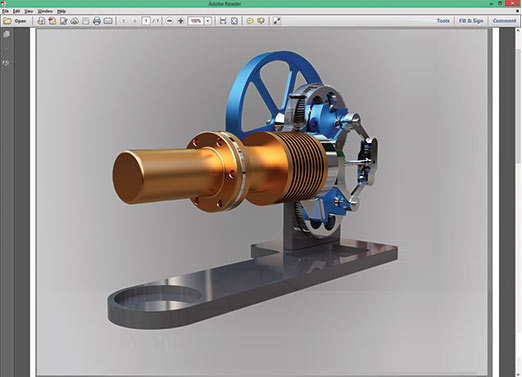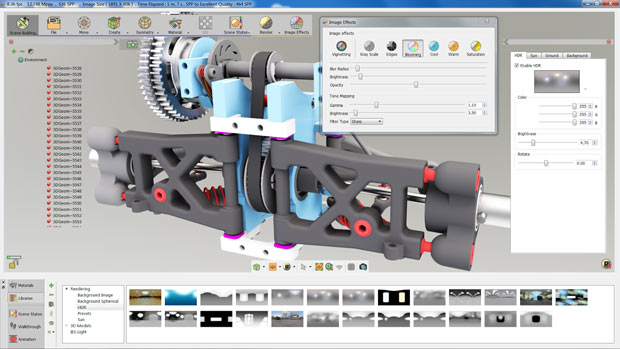
SimLab Composer’s real-time-rendering workbench provides four rendering modes, a materials library, the ability to drag-and drop materials during a rendering, and a variety of image effects and lighting environments, including HDR (high-dynamic-range rendering) and Sun. Image courtesy of SimLab Soft.
Latest News
June 1, 2016
Simulation Lab Software LLC (SimLab Soft) has released version 7 of SimLab Composer, its 3D visualization and file-sharing platform. Among the features in version 7 highlighted by the company are a new user interface, a variety of features for creating renderings and performance enhancements. SimLab Composer, a Windows 64-bit and Macintosh solution, comes in editions tailored for mechanical designers, architects, home enthusiasts and 3D artists and modelers.
 SimLab Composer 7 debuts a new user interface that’s intended to optimize workflows for new users as well as advanced users. Image courtesy of SimLab Soft.
SimLab Composer 7 debuts a new user interface that’s intended to optimize workflows for new users as well as advanced users. Image courtesy of SimLab Soft.SimLab Soft says that SimLab Composer aims to provide MCAD users with a simple, powerful and affordable solution to do creative visualizations of 3D models. With it, adds the company, users can work with any 3D model, regardless of format, design application or model size to render images, execute physical and mechanical simulations modeling an object’s dynamic behavior, create animations such as walk-throughs and produce, publish and share 3D interactive manuals and assembly instructions and the like.
The company offers integration plug-ins for such mechanical design solutions as Fusion 360, Onshape and ZW3D that enable users of those applications to use the full complement of SimLab Composer’s tools. With the integration plug-in, you can establish a link with your MCAD environment to keep data in sync as well as transfer a scene from your MCAD system to SimLab Composer at anytime during a design session.
SimLab Composer is made up of workbench tool-set modules for animating, simulating and real-time rendering of 3D models. Additionally, it has two workbenches for specialized operations: Texture Baking and Expo.
Texture Baking, explains SimLab Soft, is a rendering-to-texture workbench that allows you to create texture maps based on an object’s appearance in a rendered scene. The textures are “baked” into the object via mapping, resulting in a more realistic looking rendering. How it works is that Text Baking calculates environmental information such as lights and shadows then renders that data as a texture. Texture Baking is supported on Microsoft Windows versions of the application only.
 SimLab Composer’s real-time-rendering workbench provides four rendering modes, a materials library, the ability to drag-and drop materials during a rendering, and a variety of image effects and lighting environments, including HDR (high-dynamic-range rendering) and Sun. Image courtesy of SimLab Soft.
SimLab Composer’s real-time-rendering workbench provides four rendering modes, a materials library, the ability to drag-and drop materials during a rendering, and a variety of image effects and lighting environments, including HDR (high-dynamic-range rendering) and Sun. Image courtesy of SimLab Soft.SimLab Software says that its Expo workbench mode is rarely found in 3D applications. The Expo workbench provides customized tools for organized presentations, such as interactive walk-throughs and simulations, client presentations, trade show displays/exhibits, advertisements and slide shows of image galleries. It enables you to use your full display screen even if it’s larger than your 3D area, and you can use its supplied materials as well as your own. You can also apply materials, scene states, environments and backgrounds instantly without leaving the Expo workbench for the main Composer application, according to the company.
SimLab Composer’s 3D file sharing can be accomplished through either the SimLab Composer Sharing Workbench or through a SimLab plug-in for such applications as Maya, PTC Creo, SOLIDWORKS and Solid Edge. Import/export formats include 3D PDF, WebGL (HTML) and the SimLab CAD Viewer. The latter is a free application that allows you to view and navigate models on Android and iOS mobile devices.
 SimLab Composer supports one-click 3D PDF document creation of your animations. It comes with a template designer for editing and creating your own document formats as well as a variety of pre-defined templates. Image courtesy of SimLab Soft.
SimLab Composer supports one-click 3D PDF document creation of your animations. It comes with a template designer for editing and creating your own document formats as well as a variety of pre-defined templates. Image courtesy of SimLab Soft.The new user interface introduced in SimLab Composer 7 is designed to optimize workflows for beginners as well as advanced users, according to the company. Workbenches are arrayed across the top of the screen for ease access to and switching between functionality as you develop a visualization. Tool menus are context-sensitive to the task at hand.
In addition to its new user interface, SimLab Composer 7 includes new features for mesh decimation, composite path creations for animations and simulations, a new 3D object library and functionality for sun and shadow studies. WebGL has been optimized for faster downloads and a better navigation experience. Support for billboards in 3D PDF and WebGL has been added. Simulations now offer a new point to curve joint capability and new joint limits.
 The Scene Building workbench in SimLab Composer provides the necessary tools related to building a model scene as well as applying texturing and lighting in preparation for animation, simulation, rendering and file sharing through 3D PDF, WebGL (HTML) and the SimLab CAD Viewer for Android/iOS devices. Image courtesy of SimLab Soft.
The Scene Building workbench in SimLab Composer provides the necessary tools related to building a model scene as well as applying texturing and lighting in preparation for animation, simulation, rendering and file sharing through 3D PDF, WebGL (HTML) and the SimLab CAD Viewer for Android/iOS devices. Image courtesy of SimLab Soft.Pricing for SimLab Composer 7 begins at $20 a month ($240/year) for a single-user perpetual license. Contact the company for details on pricing for floating licenses, upgrades from previous versions and the SimLab Composer software developer kit.
For more information on SimLab Composer 7, click here.
Download a free trial of SimLab Composer 7 for Windows and Mac here.
Check out some SimLab Composer 7 tutorials.
Watch an introduction to Expo Workbench.
Take a look at the new interface in SimLab Composer.
See why DE‘s editors selected SimLab Composer 7 as their Pick of the Week.
Sources: Press materials received from the company and additional information gleaned from the company’s website.
Subscribe to our FREE magazine, FREE email newsletters or both!
Latest News
About the Author
Anthony J. Lockwood is Digital Engineering’s founding editor. He is now retired. Contact him via [email protected].
Follow DE





